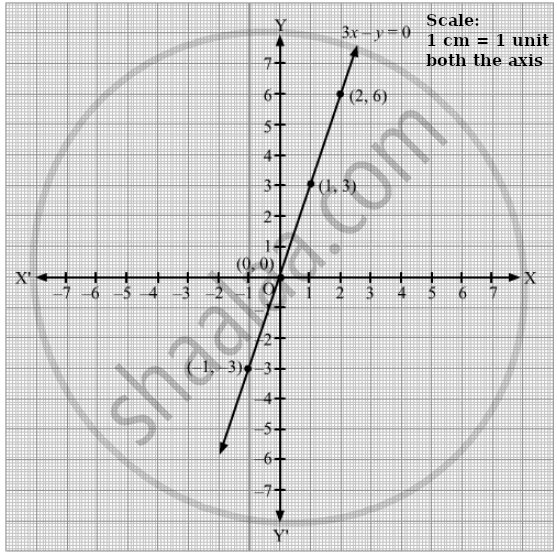Advertisements
Advertisements
प्रश्न
Draw the graph of the equation given below.
3x - y = 0
उत्तर
The equation of the given line is 3x − y = 0.
∴ 3x − y = 0
⇒ y = 3x ...(1)
Putting x = 0 in (1), we get
y = 3 × 0
y = 0
Putting x = 1 in (1), we get
y = 3 × 1
y = 3
Putting x = −1 in (1), we get
y = 3 × (−1)
y = −3
Putting x = 2 in (1), we get
y = 3 × 2
y = 6
These values can be represented in the table in the form of ordered pairs as follows:
| x | 0 | 1 | -1 | 2 |
| y | 0 | 3 | -3 | 6 |
| (x, y) | (0, 0) | (1, 3) | (-1, -3) | (2, 6) |

The line is the graph of the equation 3x − y = 0.
APPEARS IN
संबंधित प्रश्न
Draw the graph of the equation given below.
2x + y = 1
Draw the graph for the linear equation given below:
2x - 7 = 0
Draw the graph for the equation given below:
2x - 5y = 10
For the linear equation, given above, draw the graph and then use the graph drawn (in the following case) to find the area of a triangle enclosed by the graph and the co-ordinates axes:
7 - 3 (1 - y) = -5 + 2x
On the same graph paper, plot the graph of y = x - 2, y = 2x + 1 and y = 4 from x= - 4 to 3.
On the same graph paper, plot the graphs of y = 2x - 1, y = 2x and y = 2x + 1 from x = - 2 to x = 4. Are the graphs (lines) drawn parallel to each other?
Draw the graph of equation `x/(4) + y/(5) = 1` Use the graph drawn to find:
(i) x1, the value of x, when y = 10
(ii) y1, the value of y, when x = 8.
Find if the following points are collinear or not by using a graph:
(i) (-2, -1), (0, 3) and (1, 5)
(ii) (1, 3), (-2, -4) and (3, 5)
(iii) (2, -1), (2, 5) and (2, 7)
(iv) (4, -1), (-5, -1) and (3, -1)
Draw a graph of each of the following equations: 3y + 2x = 11
Draw a graph of each of the following equations: y = `(5)/(2) xx + (2)/(5)`
